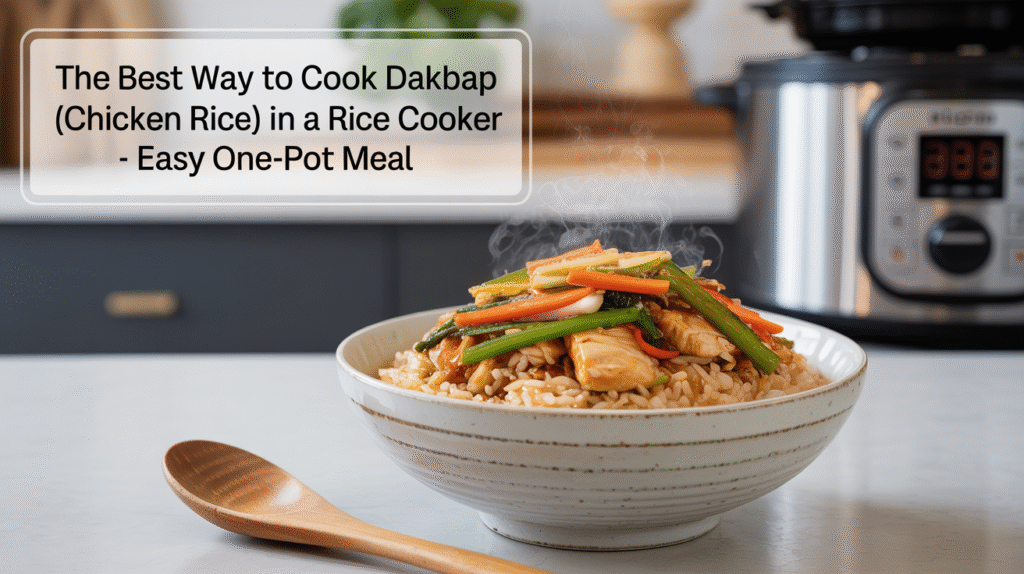The simplest way to make dakbap (chicken rice) in a rice cooker is to combine rinsed short‑grain rice with marinated chicken and seasonings, letting the cooker steam everything together for a savoury, protein‑rich meal. This method gives you tender rice infused with chicken flavour in one pot, with minimal prep and cleanup.

What Is Dakbap?
Dakbap (닭밥) literally translates to “chicken rice.” In Korean home cooking, it’s a practical, comforting dish where chicken cooks directly with rice, often seasoned lightly with soy sauce, garlic, and sesame oil. Instead of preparing meat and rice separately, both are cooked together in the same pot, creating a flavourful base dish that can be eaten on its own or paired with side dishes.
Why Make Dakbap in a Rice Cooker
- It saves time by cooking rice and chicken together.
- The cooker ensures even heat, keeping rice tender and chicken moist.
- It’s versatile: you can adjust the flavours to taste, from mild and kid‑friendly to spicier variations.
Ingredients for Dakbap
Gather simple but fresh ingredients for the best results.
Core Ingredients
- 2 cups short‑grain rice (300 g), rinsed well
- 2½ cups water or chicken stock (600 ml)
- 200–250 g chicken thigh or breast, cut into bite‑sized cubes
- 1 tbsp soy sauce for seasoning
- 1 tsp sesame oil for aroma
- 1 tsp minced garlic
- ½ tsp salt (adjust to taste)
Optional Additions
- ½ onion, sliced for sweetness
- ½ carrot, diced for colour and nutrition
- 1 tsp gochujang (Korean red chilli paste) for spice
- Spring onion as garnish
Step‑by‑Step Instructions
Cooking dakbap in a rice cooker is straightforward and requires little active attention.
- Rinse the rice thoroughly until the water runs mostly clear, then drain.
- Marinate chicken lightly with soy sauce, garlic, sesame oil, and a pinch of salt while preparing other ingredients.
- Add rice to cooker and pour in water or chicken stock.
- Layer chicken and vegetables on top of the rice. Do not stir at this stage; letting them rest on top helps even cooking.
- Start the rice cooker on the standard “White Rice” or “Mixed Rice” programme.
- Allow cooking cycle to finish (25–45 minutes depending on model).
- Rest for 10 minutes on “Keep Warm” mode to let flavours settle.
- Fluff gently with a rice paddle, mixing chicken and vegetables into the rice.
- Serve immediately with optional garnish like spring onions or sesame seeds.
Cook Times and Yield
Cooking times depend on your machine type, but general guidelines are:
- Basic rice cooker: 25–30 minutes + 10 minutes resting
- Fuzzy logic/multicooker: 40–50 minutes + 10 minutes resting
Yield: 4 servings from 2 cups of uncooked rice and 200–250 g chicken.
Variations of Dakbap
This one‑pot chicken rice can be adapted to different tastes.
Flavour Variations
- Soy‑garlic: mild and savoury, perfect for family meals.
- Spicy gochujang: add 1–2 tsp gochujang or chilli flakes for a punchier dish.
- Brothy style: use more stock (up to 3 cups) for softer, porridge‑like rice.
Protein Options
- Use boneless chicken thighs for juicier meat.
- Swap chicken for tofu or seitan for a vegetarian‑friendly version.
Tips and Common Mistakes
Attention to small details ensures your dakbap turns out perfectly.
Tips
- Use chicken stock instead of water for richer flavour.
- Cut chicken into small, even pieces for uniform cooking.
- Resting the rice after cooking helps flavours distribute evenly.
Mistakes to Avoid
- Overloading the cooker with too much chicken can make rice soggy.
- Stirring before cooking can lead to uneven rice texture.
- Using too little seasoning may result in bland rice since chicken flavour is subtle.
Troubleshooting
If results aren’t as expected, here are some easy fixes.
Rice Too Wet
Use slightly less water (2¼ cups instead of 2½) next time, especially if using juicy chicken thighs.
Rice Too Dry
Add 2–3 tbsp more water or stock on your next attempt.
Chicken Undercooked
Cut chicken into smaller cubes or sauté briefly before adding to the rice cooker.
Serving Suggestions
Dakbap can be enjoyed as a complete dish or as part of a larger meal.
- Pair with kimchi, stir‑fried greens, or seasoned bean sprouts (namul).
- Top with a fried egg for extra richness.
- Add a side of miso soup or clear broth for balance.
Storage and Reheating
Proper storage helps maintain flavour and texture.
- Refrigerate leftovers in airtight containers for up to 3 days.
- Freeze in portions for up to 1 month.
- Reheat in a microwave with 1–2 tsp added water, covered, for 1–2 minutes until hot.
Nutrition Snapshot (Per Serving, Approx.)
Based on recipe with chicken breast and soy seasoning:
- Calories: ~280–320 kcal
- Carbohydrates: ~45 g
- Protein: ~16–18 g
- Fat: ~5–7 g
- Fibre: ~2 g
Rice Cooker Compatibility
Most rice cookers handle dakbap well, but settings may need adjustment.
- Basic cookers: Use standard “Cook” cycle and allow 10 minutes resting.
- Fuzzy logic/multicookers: Choose “Mixed Rice” or “Rice + Meat” mode for even better results.
FAQs
Here are some questions and answers about Dakbap (Chicken Rice) in a Rice Cooker.
Can I use frozen chicken?
Yes, but thaw completely before adding to ensure even cooking with rice.
Which chicken cut is best?
Thighs stay juicier, while breasts are leaner. Both work well depending on preference.
Can I double the recipe?
Yes, if your cooker has enough capacity. Keep the same rice‑to‑water ratio.
Is dakbap spicy?
Not by default. The base recipe is mild, but adding gochujang or chilli flakes can make it spicy.
Can I make it vegetarian?
Yes, swap chicken for firm tofu and use vegetable stock instead of chicken stock.
How long can it sit on “Keep Warm”?
Up to 6 hours, though flavour and texture are best within 2–3 hours.